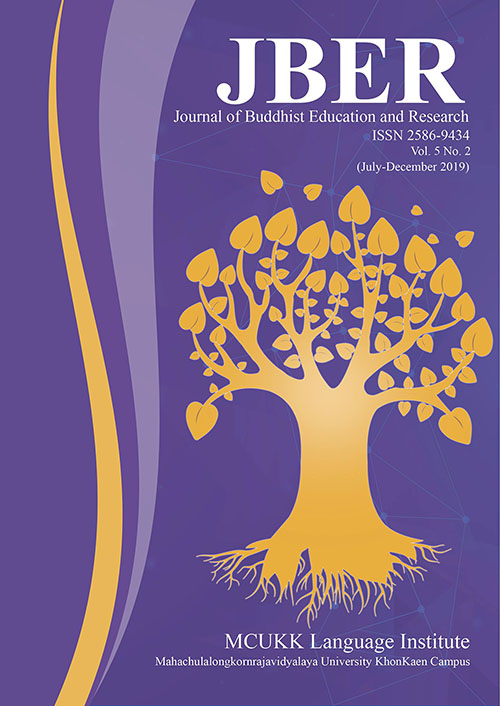THE MANAGEMENT OF THE BUDDHIST INTEGRATIVE DHAMMA PRACTICE CENTERS
Keywords:
Management, Dhamma practice centers, Buddhist IntegrativeAbstract
This article aims to analyze of managing the Buddhist integrative Dhamma practice centers by integrating Buddhism with modern science as follows : the Buddhist management concepts is working with intellect and with good intentions for society and the professional Buddhist executives compose 3 ways which are 1) Chakkhuma has intelligence and foresight,
2) Vithuro manages the business well with expertise in, 3) Nissayasampanno can rely on other people in order to manage the Dharma practice centers to be 7 comfort places (Sappaya) that are : (1) Avasasappaya means the place that is happy to be clean, safe, (2) Gocarasappaya means the place that traveling around the alms well suited, (3) Bhassasappaya means the place has moderately appropriate conversation, (4) Puggalasappaya means the place compose with people are friendly friends, (5) Bhojanasappaya means the place has nutritious food, (6) Utusappaya the place has a natural environment and (7) Ariyapathadasappaya means the posture is comfortable. All will be Integrated with the management according to modern science of the Dharma practice centers in the management of various aspects of the 4 M principles, including man, money, Material and Management and with the management process to analyze SWOT principles to achieve a collaborative process to be efficient and efficiency and maximum effectiveness, and to achieve the objectives or goals of the Dharma practice centers set up to date in the 21st century.
Keywords : Management, Dhamma practice centers, Buddhist Integrative
References
แก้ว ชิดตะขบ. (2553). ประวัติความสำคัญของการเผยแผ่พระพุทธศาสนา. กรุงเทพฯ: โรงพิมพ์สำนักงานพระพุทธศาสนาแห่งชาติ.
จำนงค์ ทองประเสริฐ. (2547). แผนการกู้อิสรภาพของเจ้าชายสิทธัตถะ. พิมพ์ครั้งที่ 5. กรุงเทพฯ: สำนักพิมพ์ดวงแก้ว.
ณัฐสิทธิ์ วงค์ตลาด. (2559). การจัดการเผยแผ่พระพุทธศาสนาของสำนักปฏิบัติธรรมในจังหวัดอุดรธานี. ดุษฎีนิพนธ์พุทธศาสตรดุษฎีบัณฑิต. บัณฑิตวิทยาลัย : มหาวิทยาลัยมหาจุฬาลงกรณราชวิทยาลัย.
ทศพร ศิริสัมพันธ์. (2539). ความรู้เบื้องต้นเกี่ยวกับนโยบายสาธารณะ. กรุงเทพฯ: โรงพิมพ์แห่งจุฬาลงกรณ์มหาวิทยาลัย.
พระธรรมโกศาจารย์ (ประยูร ธมฺมจิตฺโต). (2549). พุทธวิธีบริหาร. กรุงเทพฯ: โรงพิมพ์มหาจุฬาลงกรณราชวิทยาลัย.
_______. (2548). การเผยแผ่เชิงรุก. กรุงเทพฯ: โรงพิมพ์มหาจุฬาลงกรณราชวิทยาลัย.
พระธรรมปิฎก (ป. อ. ปยุตฺโต). (2551). พจนานุกรมพุทธศาสตร์ ฉบับประมวลธรรม. พิมพ์ครั้งที่ 17. กรุงเทพฯ: โรงพิมพ์มหาจุฬาลงกรณราชวิทยาลัย.
พระมหาสุทิตย์ อาภากโร. (2556). การพัฒนาระบบการบริหารจัดการและการสร้างเครือข่ายองค์กรพระพุทธศาสนาในประเทศไทย. รายงานการวิจัย. กรุงเทพฯ: สำนักงานกองทุนสนับสนุนการสร้างเสริมสุขภาพ.
มหาจุฬาลงกรณราชวิทยาลัย. (2539). พระไตรปิฎกภาษาไทย ฉบับมหาจุฬาลงกรณราชวิทยาลัย. กรุงเทพฯ: โรงพิมพ์มหาจุฬาลงกรณราชวิทยาลัย.
มานพ นักการเรียน. (2544). พระพุทธศาสนากับโลกปัจจุบัน. กรุงเทพฯ: โรงพิมพ์มหาจุฬาลงกรณราชวิทยาลัย.
วิโรจน์ สารรัตนะ. (2545). การบริหารหลักการทฤษฎีและประเด็นการศึกษา. กรุงเทพฯ: ทิพยวิสุทธิ.
ศิริวรรณ เสรีรัตน์. (2539). องค์การและการจัดการ. กรุงเทพฯ: ธีระฟิล์มและไซเท็กซ์.
ศูนย์เทคโนโลยีสารสนเทศ สำนักงานพระพุทธศาสนาแห่งชาติ. (2557). ข้อมูลพื้นฐานทางพระพุทธศาสนาปี 2557. กรุงเทพฯ: โรงพิมพ์สำนักงานพระพุทธศาสนาแห่งชาติ.
สำนักงานพระพุทธศาสนาแห่งชาติ. (2551). คู่มือปฏิบัติงานหน่วยอบรมประชาชนประจำตำบล. กรุงเทพฯ: โรงพิมพ์สำนักงานพระพุทธศาสนาห่างชาติ.
สุธี สุทธิสมบูรณ์ และสมาน รังสิโยกฤษฎ์. (2541). หลักการบริหารเบื้องต้น. พิมพ์ครั้งที่ 17. กรุงเทพฯ: สานักพิมพ์ ก.พ.
Holt,D.H. (1993). Management printciples and practices. New Jersey: Prentice – Hall.
Wagner & Hollenbeck. (1995). Management of organization behavior. New Jersey: Prentice – Hall.





